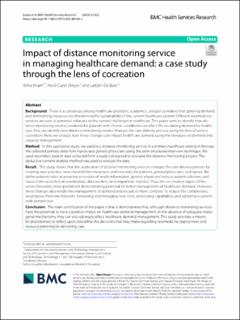| dc.description.abstract | Background
There is a consensus among healthcare providers, academics, and policy-makers that spiraling demand and diminishing resources are threatening the sustainability of the current healthcare system. Different telemedicine services are seen as potential solutions to the current challenges in healthcare. This paper aims to identify how distance monitoring services rendered for patients with chronic conditions can affect the escalating demand for healthcare. First, we identify how distance monitoring service changes the care delivery process using the lens of service cocreation. Next, we analyze how these changes can impact healthcare demand using the literature on demand and capacity management.
Method
In this qualitative study, we explore a distance monitoring service in a primary healthcare setting in Norway. We collected primary data from nurses and general physicians using the semi-structured interview technique. We used secondary patient data collected from a study conducted to evaluate the distance monitoring project. The deductive content analysis method was used to analyze the data.
Result
This study shows that the application of distance monitoring services changes the care delivery process by creating new activities, new channels for interaction, and new roles for patients, general physicians, and nurses. We define patients’ roles as proactive providers of health information, general physicians’ roles as patient selectors, and nurses’ roles as technical coordinators, data workers, and empathetic listeners. Thus, the co-creation aspect of the service becomes more prominent demonstrating potential for better management of healthcare demand. However, these changes also render the management of demand and resources more complex. To reduce the complexities, we propose three mechanisms: foreseeing and managing new roles, developing capabilities, and adopting a system-wide perspective.
Conclusion
The main contribution of the paper is that it demonstrates that, although distance monitoring services have the potential to have a positive impact on healthcare demand management, in the absence of adequate managerial mechanisms, they can also adversely affect healthcare demand management. This study provides a means for practitioners to reflect upon and refine the decisions that they make regarding telemedicine deployment and resource planning for delivering care. | en_US |

